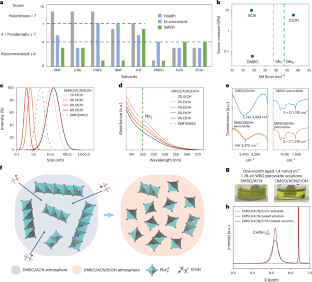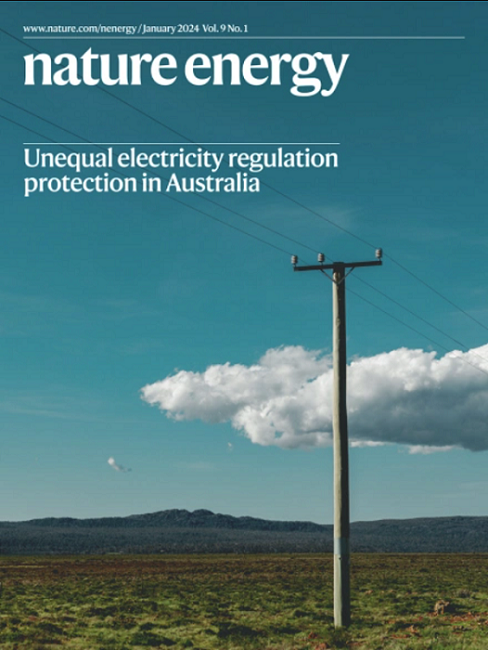Scalable fabrication of wide-bandgap perovskites using green solvents for tandem solar cells
IF 49.7
1区 材料科学
Q1 ENERGY & FUELS
引用次数: 0
Abstract
Commercializing perovskite-based tandems necessitates environmentally friendly solvents for scalable fabrication of efficient wide-bandgap (WBG) (1.65–1.80 eV) perovskites. However, the green solvents developed for formamidinium lead iodide-based ~1.50-eV-bandgap perovskites are unsuitable for WBG perovskites due to the low solubility of caesium and bromide salts, leading to reliance on toxic N,N-dimethylformamide solvent. Here we present a green solvent system comprising dimethyl sulfoxide and acetonitrile to effectively dissolve the named salts, with the addition of ethyl alcohol to prevent precursor degradation and to extend the solution processing window. Using this green solvent mixture, we achieve blade-coated WBG perovskite solar cells with power conversion efficiencies of 19.6% (1.78 eV) and 21.5% (1.68 eV). We then demonstrate 20.25-cm2 all-perovskite tandem solar modules with a power conversion efficiency of 23.8%. Furthermore, we achieved WBG perovskites deposited in ambient air and narrow-bandgap perovskites fabricated using the same green solvents, which promotes the viability of environmentally friendly fabrication. The sustainable fabrication of perovskite solar cells is critical. Duan et al. present a more environmentally friendly solvent system to process wide-bandgap perovskite films that can also be used for industrial-scale manufacturing in ambient air.


利用绿色溶剂为串联太阳能电池规模化制造宽带隙过氧化物
要实现基于包光体的串联产品的商业化,就必须使用环保溶剂,以实现高效宽带隙(WBG)(1.65-1.80 eV)包光体的规模化制造。然而,由于铯盐和溴盐的溶解度较低,为碘化甲脒铅基 ~1.50 eV 带隙包光体开发的绿色溶剂并不适合 WBG 包光体,从而导致对有毒的 N,N-二甲基甲酰胺溶剂的依赖。在这里,我们提出了一种由二甲亚砜和乙腈组成的绿色溶剂系统,可有效溶解上述盐类,同时添加乙醇以防止前驱体降解并延长溶液处理时间。利用这种绿色混合溶剂,我们实现了叶片涂层 WBG 包晶太阳能电池,其功率转换效率分别为 19.6% (1.78 eV) 和 21.5% (1.68 eV)。然后,我们展示了 20.25 平方厘米的全包晶串联太阳能模块,其功率转换效率为 23.8%。此外,我们还实现了在环境空气中沉积 WBG 包晶石,并使用相同的绿色溶剂制造窄带隙包晶石,从而提高了环保制造的可行性。
本文章由计算机程序翻译,如有差异,请以英文原文为准。
求助全文
约1分钟内获得全文
求助全文
来源期刊

Nature Energy
Energy-Energy Engineering and Power Technology
CiteScore
75.10
自引率
1.10%
发文量
193
期刊介绍:
Nature Energy is a monthly, online-only journal committed to showcasing the most impactful research on energy, covering everything from its generation and distribution to the societal implications of energy technologies and policies.
With a focus on exploring all facets of the ongoing energy discourse, Nature Energy delves into topics such as energy generation, storage, distribution, management, and the societal impacts of energy technologies and policies. Emphasizing studies that push the boundaries of knowledge and contribute to the development of next-generation solutions, the journal serves as a platform for the exchange of ideas among stakeholders at the forefront of the energy sector.
Maintaining the hallmark standards of the Nature brand, Nature Energy boasts a dedicated team of professional editors, a rigorous peer-review process, meticulous copy-editing and production, rapid publication times, and editorial independence.
In addition to original research articles, Nature Energy also publishes a range of content types, including Comments, Perspectives, Reviews, News & Views, Features, and Correspondence, covering a diverse array of disciplines relevant to the field of energy.
 求助内容:
求助内容: 应助结果提醒方式:
应助结果提醒方式:


